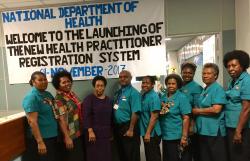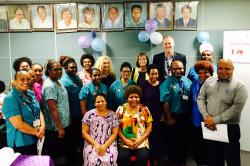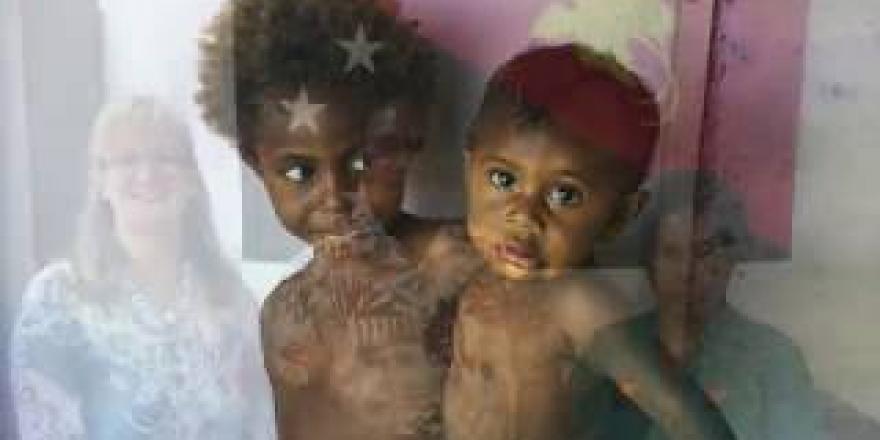PNG Health Practitioners Registration System launched

Hon. Sir Dr. Puka Temu, MInister for Health/HIV AIDS; Mr Pascoe Kase, Secretary for Health; Ms Christine Sturrock, DFAT Counsellor, Health and HIV, Australian High Commission Port Moresby, launch the new Health Practitioners Registration System.
A new electronic database, a vital source of information for health workforce planning in Papua New Guinea, was launched November 1, 2017. The new database holds details of all registered nurses and midwives in Papua New Guinea, including new and overseas nurses and midwives. Previously these professionals were recorded in a paper based system which was outdated and inaccurate. There were many people recorded more than once, or nurses and midwives who had retired or moved away were still on the record. There was very little knowledge of who and how many health workers were available in Papua New Guinea.

Minister of Health and DFAT launching the new registration system
The Minister for Health, the Honorable Sir Dr Puka Temu, launched the new Health Practitioners Registration System welcoming hundreds of government officials, all National Department of Health units were represented along with health care workers and the press. Mr Peter Pindan, Chairman of the Nursing Council, opened the day with speeches and presentations provided by the Secretary for Health, Mr Pascoe Kase, Ms Christine Sturrock from Department of Foreign Affairs and Trade Australia, Acting Nursing Council Registrar, Dr Nina Joseph, Technical Advisor Ms Margaret Asinimbu, and WHO Collaborating Centre for Nursing, Midwifery and Health Development Technical Advisor, Ms Michele Rumsey.
This new system followed years of work at the Nursing Council, which is part of the National Department of Health Papua New Guinea. The Nursing Council, alongside the nursing and midwifery workforce, has faced many key workforce issues and need for institutional reform. 2016 was a year of significant development for Nursing Council registration data review, policies and accreditation audits of training institutions. The Nursing Council has now undertaken the majority of the outstanding accreditation audits for existing and proposed Diploma of General Nursing (DGN) programs. During the 2014-2016 period, the Nursing Council conducted 25 visits to 14 Institutes, and met with over 2,000 stakeholders and associated facilities. This has been a significant achievement considering funding constraints and the remote location of institutes and their associated health facilities. Please find key documents on the new Nursing Council webpage: www.health.gov.pg and click on Nursing.

Nursing Council of Papua New Guinea
“A revision of the Health Practitioner Registration Systems (HPRS) has been carried out during 2014–2016 period, this will have a significant impact on registration of health professionals so we can maintain a quality health workforce and plan for the future, ” said Nursing Board Chair Mr Peter Pindan.
The work of the Nursing Council can only be carried out with the support and extremely hard work of the Nursing Council Committee members. Stakeholders from the National Department of Health (NDoH); health facilities run by public, private, church and non-governmental organisations; provincial and government offices; Department of Labour and Industrial Relations; World Health Organization; Department Affairs and Trade Australian High Commission; and the Office of Higher Education Research Science and Technology have all contributed significantly to the running of the Nursing Council in 2016. We thank you all.
“It must also be stated that although an enormous amount of work has been carried out on registration data, there are more areas that can be analysed in the Health Practitioners’ Registration System (HPRS). This will allow us accurate information on registrants and enable us to carry out our mandated role to protect the public by requiring a certain level of education of our registered nurses and midwives,” said Acting Registrar, Dr Nina Joseph. “The way we work must be sensitive and relevant and must meet the needs of patients and communities. We must be able to adjust our practice to changing circumstances, taking into consideration local procedures, policies and cultural difference.”

National Department of Health, Nursing Council, DFAT and stakeholders
Because of the major reform of the Nursing Council and updated information available, it is now known that 6,271 nurses and midwives are currently registered in Papua New Guinea (well below the WHO recommended threshold of 45 health workers per 10,000 population). However, of these 4,566 are registered nurses, 721 are registered midwives and 1,427 are nurse aides.
This work has been supported by the World Health Organization Collaborating Centre for Nursing, Midwifery and Health Development at the University of Technology Sydney and funded by the Department of Foreign Affairs Australia.

Nursing Council 2014-2017
